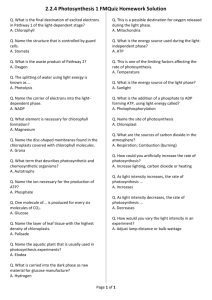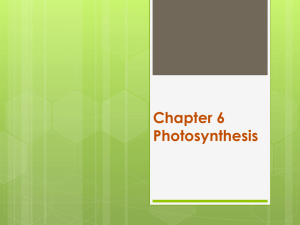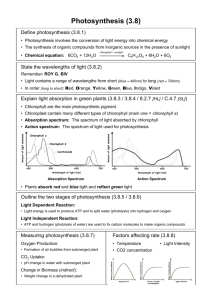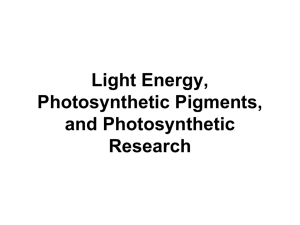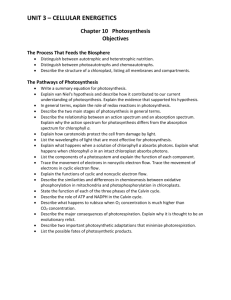Exercise #6 PHOTOSYNTHESIS
advertisement
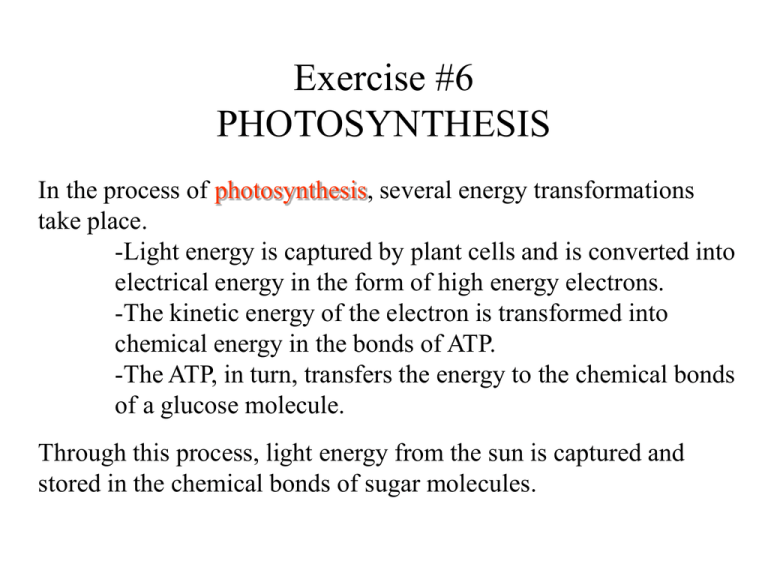
Exercise #6 PHOTOSYNTHESIS In the process of photosynthesis, several energy transformations take place. -Light energy is captured by plant cells and is converted into electrical energy in the form of high energy electrons. -The kinetic energy of the electron is transformed into chemical energy in the bonds of ATP. -The ATP, in turn, transfers the energy to the chemical bonds of a glucose molecule. Through this process, light energy from the sun is captured and stored in the chemical bonds of sugar molecules. Exercise #6 PHOTOSYNTHESIS PHOTOSYNTHETIC PIGMENTS The initial step of photosynthesis involves the capture of light energy by the photosynthetic pigment, chlorophyll. However, the plant does not absorb all of the light energy in the visible portion of the electromagnetic spectrum. -Figure 6.1 of your lab manual represents the visible portion of the electromagnetic spectrum. In this exercise, you will use the spectrophotometer to determine which wavelengths of light are absorbed and which ones are reflected by the chlorophyll molecule. Exercise #6 PHOTOSYNTHESIS PROCEDURE In order to study the absorbance of various wavelengths of light by chlorophyll, you must first separate the pigment from the leaf tissue. This is accomplished by following the procedure below: 1) Place a large spinach leaf into a 50 ml beaker and add 30 ml of ethanol. 2) Place the beaker with ethanol on a hot plate and slowly heat the solution taking care not to crush the leaf or boil the ethanol solution. 3) As the chlorophyll exits the leaf tissue it will enter the ethanol solution and turn the color green. 4) Fill the cuvette approximately 2/3 full will the chlorophyll extract. Refer to the diagrams on the right for a representation of the chlorophyll extract. Exercise #6 PHOTOSYNTHESIS At this point, we wish to determine which wavelengths of light are absorbed by the chlorophyll extract. However, we must first ensure that the concentration of chlorophyll in the solution is appropriate for the experiment. To do this, follow the procedure below: 1) Set the spectrophotometer at 550 nm and depress the %T button. 2) Place a cuvette filled 2/3 full of ethanol into the sample compartment and calibrate to 100 %T. 3) In order to continue on with the absorption experiment you must obtain a reading between 65% - 85%. -If you have a reading below 65%, your experimental solution is too concentrated--what should you do to change its concentration. Once you have reached an appropriate %T reading you are ready to continue with the experiment. Exercise #6 PHOTOSYNTHESIS Use your chlorophyll extract along with an ethanol blank and determine the absorbance of the chlorophyll solution at various wavelengths. NOTE: the procedure employed here is identical to that used in the determination of the absorption spectrum for methylene blue (Exercise #3) -remember to zero the machine after you change each wavelength. In order to clearly visualize the actual absorbance characteristics of your chlorophyll extract, you will plot your data using graphic analysis. Remember that wavelength is the independent variable and that absorbance is the dependent variable. Indicate with arrows on the x-axis the wavelengths of light most strongly absorbed by the chlorophyll extract. Exercise #6 PHOTOSYNTHESIS LIGHT INTENSITY AND PHOTOSYNTHESIS In general, as the intensity of light increases, the rate of photosynthesis increases. How does one measure the rate of photosynthesis? As you should recall, oxygen is a by-product of photosynthesis. Therefore, the photosynthetic rate can be determined by measuring the rate of oxygen production by the plant. During this portion of the laboratory you will observe the effect of light intensity on oxygen production and then make a generalization on plant survival based upon the data you have collected. PROCEDURE Exercise #6 PHOTOSYNTHESIS To determine the effect of light intensity upon photosynthetic rate, you will conduct the following experiment: 1) Obtain a piece of Elodea 5 to 6 inches in length and place it in a test tube with the cut end up. 2) Fill the test tube with NaHCO3 (serves as a source of CO2) and plug with the rubber stopper containing the bent glass pipette an a syringe.---AVOID AIR BUBBLES! 3) The position of the fluid in the pipette can be adjusted by raising or lowering the plunger in the syringe 4) Prepare a second tube filled with NaHCO3 without Elodea to act as a control for temperature and pressure fluctuations. 5) Place both tubes in a beaker filled with room temperature water. 6) Place a lamp 75 cm from the experimental beaker and set up a heat filter (additional beaker) filled with tap water placed half way between the light source and the experimental beaker. Refer to the picture on the following slide for reference. Exercise #6 PHOTOSYNTHESIS The following movie represents the experimental setup for the light intensity experiment. Exercise #6 PHOTOSYNTHESIS PROCEDURE (continued) 75 cm - Move the lamp so it is 75 cm away from the experimental tubes and place the heat filter half way between the lamp and tubes. Wait 5 minutes for equilibration. Adjust the fluids in the pipettes so that they are at the 0.2 ml mark and recalibrate only when changing the distance to the light source. Record the position of the fluid in the pipettes at 2 minute intervals for 10 minutes. 50 cm - Move the lamp forward so it is 50 cm away from the experimental tubes and again place the heat filter half way between the lamp and experimental tubes. Wait 5 minutes for equilibration and adjust the fluid in the pipettes to 0.2 ml. Repeat the experiment and record your data in table 6.4. 25 cm - Repeat the equilibration, adjustments and measurements at the 25 cm mark. your data in Table 6.4. Record Exercise #6 PHOTOSYNTHESIS The changes observed in the tube containing Elodea are the result of two simultaneous happenings: 1) the production of oxygen by Elodea which will always result in an increase in volume, and 2) fluctuations in temperature and pressure, which is why the pipette is set at the 0.2 ml mark. To obtain a true reading of oxygen production, you must subtract the control reading from the Elodea reading. Exercise #6 PHOTOSYNTHESIS Graphic Analysis Plot all three cumulative movements of fluid as a function of time on a sheet of graph paper. It is suggested that different plotting symbols be used for each distance from the light source (e.g. * for 75 cm; + for 50 cm; and - for 25 cm). Using a clear plastic ruler, draw a straight line that best fits all points for each distance. Your lines should indicate that the greater the light intensity, the greater the rate of oxygen production by the plant. Exercise #6 PHOTOSYNTHESIS CONCLUSIONS 1) You have seen that plants contain photosynthetic pigments. 2) Such pigments (chlorophyll) absorb only specific wavelengths of light. 3) The amount of light that the plant is exposed to has an influence on photosynthetic rate. This powerpoint was kindly donated to www.worldofteaching.com http://www.worldofteaching.com is home to over a thousand powerpoints submitted by teachers. This is a completely free site and requires no registration. Please visit and I hope it will help in your teaching.

